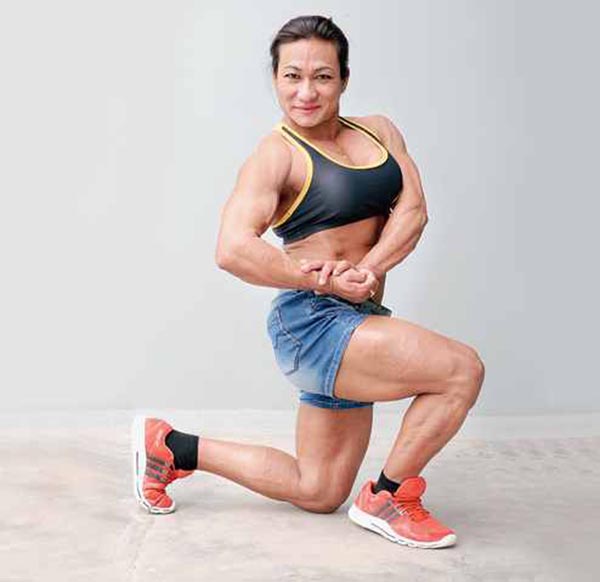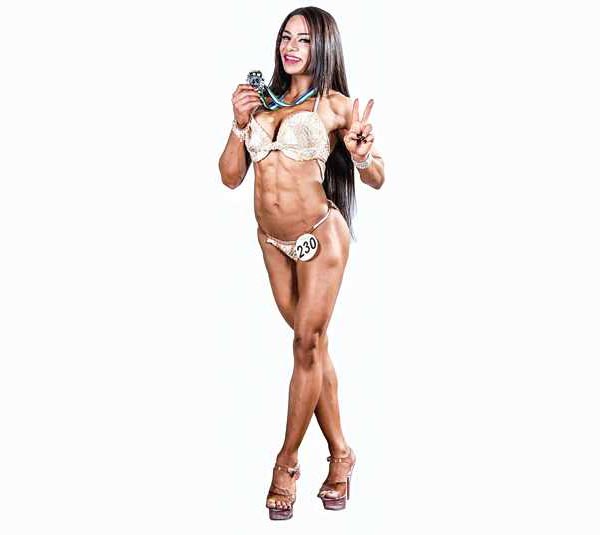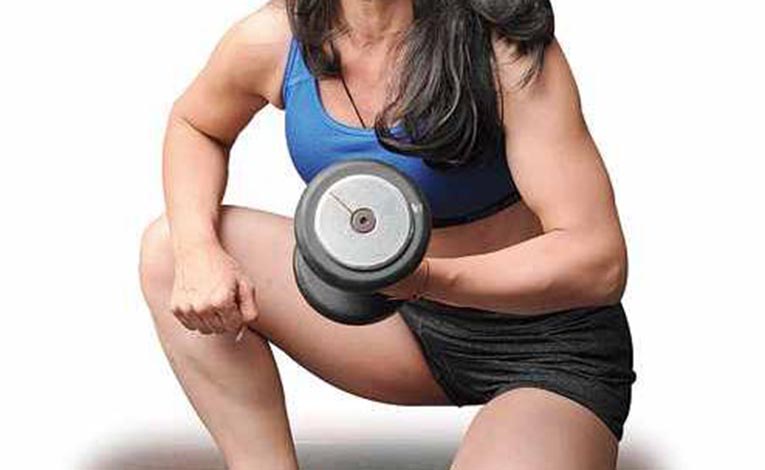She’s dressed in torn denims and a loose cotton top and, at first glance, could easily pass off as a very average suburban mother. But the moment she gets to the gym and into her sportswear 39-year-old Mamota Devi Yumnam’s transformed into an athlete with a rippling physique and taut figure.
Posing for the camera, she turns, bends her arm and hunches her shoulders for a more defined look. Her muscles bulge on command and she shows off her perfectly toned, six-pack abs.
Yumnam is India’s first woman bodybuilder to win medals at an international level. She muscled her way to bronzes at the World Women Bodybuilding Championship in Bangkok in 2012, and the Asian Bodybuilding Championship in Vietnam in 2013. She also won the gold medal at the 2014 Women’s Championship in Mumbai and, more recently, a gold at the 2015 Asian Championship in Uzbekistan.
It wasn’t long ago that bodybuilding was considered a forbidden sport for women in India. It’s still an emerging sport and can’t be compared to men’s bodybuilding. But today women are not only taking to the sport full-time — they’re even quitting high-flying jobs to fearlessly break cultural stereotypes.
“Bodybuilding was mostly dominated by the Europeans and other Asian countries like Thailand, China and Indonesia,” says Chetan Pathare, secretary, Indian Body Building Federation (IBBF). “But now India has started to register its presence by clinching medals at the international competitions.”

Take a look at 25-year-old Shweta Rathore, who won a silver medal in the fitness physique category at the Asian Bodybuilding Championship this year. Rathore chucked up her job as a vice-president with one of the country’s top real estate developers so that she could get into the sport full-time. Her instinct that she could make it in the world of bodybuilding has turned out to be absolutely right as she picked up a string of titles including Miss World 2014 Fitness Physique, Miss Asia 2015 Fitness Physique and Miss India Fitness Physique 2015. At a different level, she also became the Miss Maharashtra Sports Physique champion.
“Even when I was in school, the kids would tease me as I had a broad structure,” says Rathore who’s in a category in which participants are judged on their overall look and not just on overly powerful musculature. Judging criteria include complexion, poise, and a 90-second performance. “I wanted to work out but my father didn’t like the idea, so I used to say I was going for tuition and go to the gym,” she says. “Later, when I heard about this sport I just followed my heart,” says the Mumbai-based athlete who has just launched her gym called Fitness Forever.
For 31-year-old Natasha Pradhan, another Mumbai-based athlete, bodybuilding is not only her passion but also a way to support her 13-year-old daughter. “I’m a single mother and I want to give my daughter a secure future,” says Pradhan who used to babysit for a living. “Since I used to do kickboxing earlier, a friend suggested that I should try bodybuilding,” says the athlete who has taken part in many professional competitions.
Then there are athletes like 26-year-old Vatika Grover, a national level tennis player, who put away her racquet after 12 long years to flex her muscles. “The first time I went to a gym was when I was 22,” says Grover who finished fifth in Uzbekistan this year and seventh at the 2014 World Championship in Mumbai. She’s now focusing on bulking up. “After the Asian Championships I rea-lised that I needed to put on weight and so I’ve taken a break to increase my size and muscles,” she says.
Jinnie Gogia Chugh, on the other hand, worked in the event management industry when her gym partner suggested she should try bodybuilding. “I was a fitness freak and used to go to the gym daily; so when my friend suggested I should try my hand at bodybuilding, I just did it,” says 38-year-old Chugh, who left her company to represent India in the World Championships last year in Mumbai in the model physique category. In it participants need to have minimal body fat, a plea-sant demeanour and not be overtly muscular. Each participant gets 90 seconds to do a performance routine and strike poses.
The sport started gathering steam about two years ago when the IBBF introduced new categories in which women could compete. “Since bodybuilding wasn’t drawing many people, we introduced the Sports Physique category. In this the participants are judged on her athletic built and a pleasing stage presence,” says Pathare. To his surprise, at the national championships last year, the number of participants shot up from a mere 30 to over 70.
Bodybuilding is still an intensely challenging sport for women. For a start, they have to work twice as hard as men to develop a perfectly sculpted body. “Bodybuilding is easier for men as they have higher levels of testosterone than women,” says Yumnam, who trains for four hours daily and combines weight training with cardio and core-strengthening. “Women, on the other hand, have more estrogen and progesterone, the hormones that promote fat. I increased my intake of proteins and have lots of eggs, chicken, milk and boiled dal. It took me 18 months to get a muscular body.”

The other women bodybuilders second that. “Weeks before any competition, I stop taking salt, sugar, oil or even fruits to avoid natural sugar. Instead, I eat chicken breast, dry fruits, raw potatoes, lots of vegetables, eggs and fish,” says Rathore who trains for six hours a day. She religiously follows a fitness regime that includes doing the leg press with 450-kg weights and high intensity exercises for shoulder, abs and the back. “I also practice with my choreographer for my performances and that takes up two more hours.”
It’s a similar story of strenuous training for the others too. “I do cardio exercises, leg presses, chest and biceps exercises and others for at least five hours a day,” says Steffi D’Souza, another Mumbai-based athlete who competes in the Model Physique category. The 26-year-old believes in following the one-body-part-at-a-time approach. D’Souza, who also owns a gym in Mumbai, was a fitness trainer for seven years before taking the plunge. “Several years ago, my grandfather, Anthony D’Souza had won the Mr Bombay title in bodybuilding. So, for me you could say it runs in the family.”
And as more women flex their muscles, international fitness brands have started putting their money on these athletes.
D’Souza, for example, is backed by Unlimited Nutrition, India’s leading distributor of nutritional supplements, and Jerai Fitness, which makes fitness equipment. Similarly, Rathore is the brand ambassador for Muscletech, a US sports nutrition supplements brand. She’s also sponsored by Neulife, India’s leading sports nutrition company. “It’s an expensive sport and takes about Rs 5 lakh to Rs 6 lakh a year,” says Rathore. “I spend Rs 40,000 on my diet every month. This aside, I buy branded make-up, designer bikinis and hire a choreographer. It’s all pretty costly.”
“The supplements that I take are imported and so I end up spending about a lakh annually on my diet and fitness,” says Chugh.
But it’s still tough to get sponsorship and several women bodybuilders are struggling against the odds. K Rebita Devi is a biochemistry student and the second Indian after Yumnam to win a medal in the Bodybuilding Category — a bronze at the 2014 World Championships in Mumbai.
Despite that she has to rely on donations and fund drives by her friends to get to tournaments. “Luckily, I don’t have to pay for the gym since the people here are very helpful. Sometimes, I borrow money too,” says the iron-willed woman from Imphal who was a state-level expert at Wushu (a Chinese martial art).
“I’ve exhausted all my savings of the past 10-15 years,” says Yumnam. “With three kids, it’s even tougher though the sheer joy that I get by representing India is unparalleled. I hope to get a sponsor soon,” she says.
Unfortunately, even after bringing in medals these women have to put up with jibes and nasty comments from friends and also people on the street. “It hurts when people say that this sport isn’t for girls. They also allege that ste-roids have a big role to play in maintaining a muscular body,” says D’Souza.

Meanwhile, Yumnam has almost stopped going to the market or for other such errands. “People make awful comments like I look manly. They don’t see the effort that goes into making a body like this,” she says.
Inevitably, women bodybuilders face problems that their male counterparts don’t. At Rebita’s first public appearance in a contest that was called Mr Manipur Bodybuilding, she wore a two-piece swimsuit to show off her abs but it went against her as the other women wore more demure one-piece suits. “My bikini outraged the judges who made awful comments and I was so ashamed that I started crying on the stage,” recalls Rebita. But she was undeterred and instead made up her mind firmly to get into bodybuilding in a big way.
“I was quite anxious when we held the first World Championships in Mumbai,” says Pathare. “I didn’t know if there would be any takers, but it was well received and the spectators cheered for the participants wholeheartedly.”
Despite their tight schedules, women bodybuilders make it a point to make time for their families. “It’s important to strike that balance,” says Chugh, who has an eight-year-old daughter. “I work my schedule around her. So, I go to the gym after dropping her off to school. Luckily, my husband and my in-laws are very supportive so I manage my family without compromising my fitness regime.”
These plucky women are leaving no stone unturned to realise their dreams and put India on top of the heap. “Women can be better than men and whoever said that bodybuilding is not for us can take a hike,” says Yumnam, as she strikes an impressive pose.
Courtesy of: ABP Live
